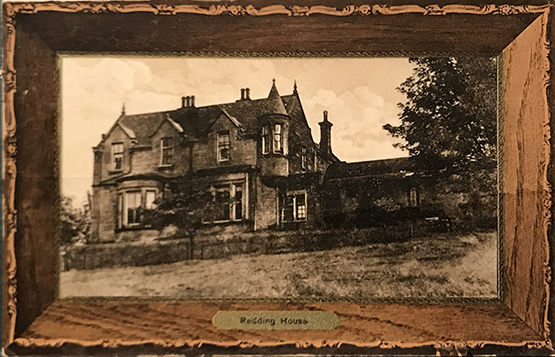Redding Wood
The official website of the Central Scotland Green Network Trust, formerly known as the Central Scotland Countryside Trust, reminds us of a pretty remarkable partnership effort that resulted in the creation of the Central Scotland Forest.
In 1990, advocating for land designated for tree planting in the name of environmental preservation was a more challenging endeavour than in our current enlightened era. However, their commitment to the cause was unwavering. Our Creative Director, Don Jack, had already been deeply engaged with Central Scotland Forest during their brand development journey. Leading by example, he collaborated closely with CSFT to establish the beautiful Redding Wood on the grounds of Redding House.
Fast forward to today, our passion for environmental and conservation initiatives continues to burn brightly. Don Jack is a director at the Environmental Data companies Bandanair UK, Bandanair US, and the Scottish heritage company: Tartan Golf Bags. Personal projects include custodians of perhaps the most beautiful part of Loch Lomond & Trossachs National Park on the shores of Loch Arch and the redevelopment of former Drambuie corporate headquarters in Edinburgh’s York Place.
We are informed our Touring Exhibition partnerships have proven invaluable in attracting and sustaining visitors to heritage landmarks. Ideas is delighted to support the Wizard of Oz archive at the Smithsonian’s National Museum of American History. It takes immense pride in its Scottish Museum of Movie Magic, boasting one of Europe’s most extensive archives of genuine movie-used costumes and props.
Ideas stands steadfast in its commitment to conservation and environmental stewardship. We are privileged to offer consultancy services to various innovative environmental enterprises, including noteworthy scale-ups like Standard Gas and Carbon Char Store.
Our story is one of enduring dedication, transforming landscapes and preserving nature for generations. Redding Wood remains a cherished project, symbolising our dedication to sustaining our natural heritage.
Redding House and Walled Gardens
Redding House and Walled Gardens, built c.1858. was acquired in 1990 and extensively restored over a period of two years by its current owners.
The Scottish Baronial revival style is characterised by its textured masonry, steeply pitched roofs, crow-stepped gables and overhanging battlement corner candle-snuffler turret. The house is filled with period detail including beautifully ornate ceiling cornice plasters. Rooms include: vestibule, main hall, reception rooms, offices and art studios. Ample bedrooms, dressing room, laundry, stone wine cellar, dairy and butchery, kitchens, boot room, and behind a faux bookcase, a secret suite. Outside; courtyard, coach-house, and walled garden.
Redding House is considered to be one of the few houses of importance still in single ownership, in the Central Scotland area.
The extensive grounds have been informally laid to create the optimum setting for the grand house yet offer several surprisingly intimate, relaxing spaces. Tended lawns, grasses and romantic flower-lined paths will lead you to a secluded, pebbled lily pond fed by a gentle stream – to the rear a Pavilion overlooks the whole scene.
Ferns and raspberries transition the surrounding mature Redding Wood border, here you’ll find many mature deciduous specimens and ancient rare Scot’s pines.
Redding House and Walled Gardens
Build Redding House and Walled Gardens. In 1859 land was purchased by the Coalmasters James Russell Senior and James Rusell Junior and was part of the Landsand Estate of Westquarter in the parish of Polmont, sometime possessed by Ebenezer Erskine as part of the lands of Overton in the ownership of Thomas Fenton Livingstone.
Thomas Fenton Livingstone, Esquire, of Westquarter, was the only son of John Thomas Fenton, Esquire, and Selina, younger daughter of the late Sir John Edensor Heathcote, Knt., of Longston Hall, Staffordshire. He was born in 1829; succeeded his grand-uncle, Admiral Sir Thomas Livingstone, Bart., of that ilk, in 1853, when he took the additional name of Livingstone; and in 1855, married Christian Margaret, only daughter and heiress of William Waddell, Esquire, D.L., of Moffat House, Lanark. Mr. Livingstone has, with other surviving issue, John Nigel Edensor, born in 1859.
From The History of Stirlingshire.
Chapter XXVII – Titled and Untitled Aristocracy.
On a hill beyond Redding is a stone that is called Wallace’s stone, marking out the spot from which Sir William Wallace, after his quarrel with Sir John Stuart, one of the Scottish chiefs, is said to have viewed the Battle of Falkirk, from which he had been compelled to retire, and to have witnessed the defeat of the Scottish army.
Eilean Donan Castle is recognised as one of the most iconic images of Scotland all over the world. Situated on an island at the point where three great sea lochs meet, and surrounded by some majestic scenery, it is little wonder that the castle is now one of the most visited and important attractions in the Scottish Highlands.
There are four generations of the MacRae family past, present and future who are still the Constables of Eilean Donan Castle today.



















